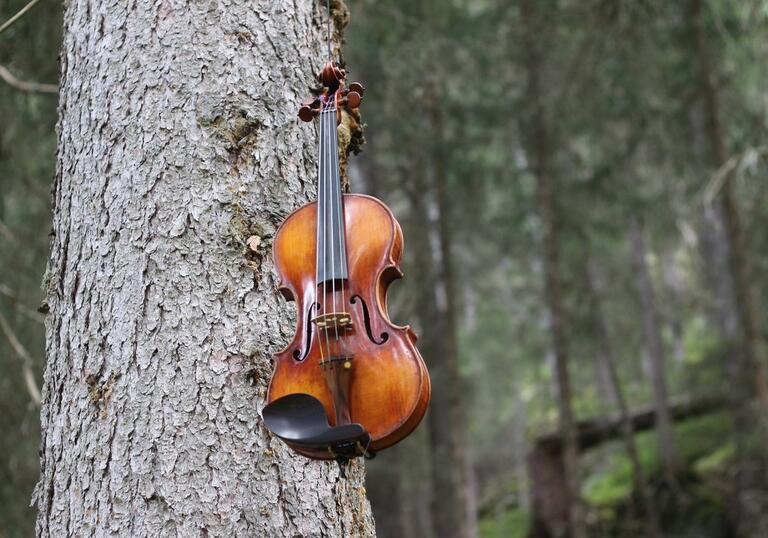Press room
Barbican Press reminder: Performance installation by Nonclassical reflecting on the climate crisis

Nonclassical
the greenhouse effect
Triangles made from re-bar (steel rods used in concrete construction), tidal bells, wind-driven Aeolian harps, and a piano prepared with single use plastic waste take root among the 1,500 species of plants in the Barbican Conservatory in the greenhouse effect - a new immersive sound experience by Nonclassical reflecting on the climate crisis.
The Barbican Conservatory’s meeting of the manmade and natural worlds, through abundant greenery, trickling water and brutalist concrete, steel and glass, provides an apt architectural setting for this collective site-specific listening experience. Audiences are invited to explore the temperate greenhouse and while witnessing performances and sound installations by multi-instrumentalist and composer Quinta, with cellist Laura Moody and composer, performer and sound artist Thanos Polymeneas-Liontiris; percussion ensemble Abstruckt; pianists Yshani Perinpanayagam and Katherine Tinker; violinist Linda Jankowska; sculptor, filmmaker and musician, Marcus Vergette, with pianist Matthew Bourne, and works by composers Andy Akiho, Carola Baukholt, Claudia Molitor, David Lang, Steve Reich and Nonclassical founder and composer Gabriel Prokofiev.
Gabriel Prokofiev’s Tracing Contours, Lines & Planes draws inspiration directly from the iconic concrete architecture of the Barbican itself, as if playing on the building’s skeleton. Performed by the London Triangle Orchestra, it will be premiered on specially constructed triangles fashioned from re-bar, the steel rods used as internal reinforcements in concrete construction.
Repurposing materials is a thread throughout the day. Carola Bauckholt’s Doppelbelichtung features violins (both played and as hanging ‘speakers’) with live string music emulating electronically-manipulated birdsong. Abstruckt Ensemble will repurpose flower pots, teacups and other junk as percussion for works by Andy Akiho, David Lang and Steve Reich. In the evening show’s finale, 16 lamps from Mátyás Wettl’s Nocturne will light up the Barbican Theatre fly tower as kinetic and light energy collide.
Other highlights include a special performance of Marcus Vergette’s Tintinnabulation, which combines the sounds of the piano with monumental bells made by sculptor/bassist/farmer Vergette. These include one of his Time and Tide bells, which are part of a wider project installed in thirteen coastal communities and played by the rising and falling tides of the sea. Vergette comments: “The bells will be on wheels so people can move around and get a different relationship to the sound as they move. And the movement of the audience changes the sound of the bells too, owing to the acoustics. It’s like a rainbow – everyone sees it, but it’s a little different for each person.’
Quinta (the stage name for London-based multi-instrumentalist Katherine Mann) handmade Aeolian harps on a residency in the Greek island, Euboea, home to a strong summer wind known as the ‘Meltemi’. The sometimes eerie, ethereal quality of Aeolian harps - named after Aeolus, the Greek god of wind - is created by the vibration of the wind on strings of different diameters stretched to the same tension across a frame; the thickness defines the sound of each string as it’s ‘played’ by the wind. Quinta’s performance for the greenhouse effect includes the use of electronic playback to bring the sound of the Meltemi wind playing her Aeolian harps into the still space of the Barbican Conservatory.
Claudia Molitor’s piano work, Polymer Hauntings is a requiem to fossil fuel and uses one of its most day-to-day, visible manifestations, plastic, sourced from audience members who will be invited to collectively listen and participate in the performance. Yshani Perinpanayagam and Katherine Tinker will perform on a piano swathed in plastic sheeting with an array of single use plastic bags and containers placed inside according to the composer's directions. Claudia Molitor comments: “I hope Polymer Hauntings will become unperformable in the very near future, due to its need for every-day, single-use plastic. In this sense I hope it is its own requiem.”
The carbon footprint of the greenhouse effect will be measured jointly by Nonclassical and the Barbican and shared following the event to include travel, energy use, waste and the procurement of anything new.
The Barbican is committed to creating a better future for everyone by reducing its impact on the environment. In line with the City of London Corporation’s Climate Action Strategy, the Barbican published its Sustainability Strategy last year which outlines the actions it is planning to take to reduce carbon emissions from its own operations to net zero by 2027, and by 2040 this will also include its supply chain. Last month, the City of London also announced that the Barbican, among other iconic City of London landmarks, will be powered by renewable electricity from a new solar farm in Dorset. Visit the Barbican’s website to find out more about its Sustainability Strategy, initiatives and progress already underway.
In tandem with the performances, two workshops for Young Barbican members aged 14-25, led by Rubbish Music (Kate Carr and Iain Chambers) use sound to investigate the journeys, transformations and impacts of our discarded objects. Using worn out treasures, empty vessels and broken devices, they examine the worlds we make and destroy through the things we leave behind. Tickets £5. https://www.barbican.org.uk/whats-on/2023/event/rubbish-music
Nonclassical - the greenhouse effect: Sun 12 Mar, Barbican Conservatory, 4pm and 7.30pm Tickets from £20 plus booking fee
Ed Maitland Smith, Communications Manager: [email protected]
Simone Gibbs, Communications Assistant: [email protected]
